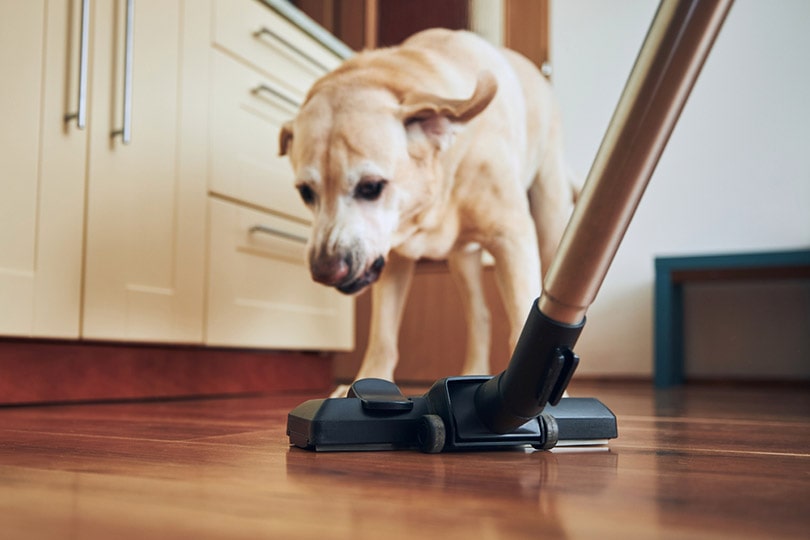How to Help a Dog’s Arthritis In Cold Weather (7 Vet-Approved Tips)
By Ashley Bates
Updated on

Any human being who is aware of what arthritis is knows how miserable it can be. Inclement weather, particularly the cold, can make arthritis flare up and be painful for the sufferer. If your dog has arthritis, you can probably see how much it can affect them—and how it can change depending on environmental factors.
Cold weather is a big trigger for arthritis. But there are measures you can put in place to soothe the symptoms so the two of you can still take walks and go out for potty breaks.
Why Does the Cold Affect Arthritis?
Anyone with arthritis will know how the cold weather worsens their symptoms, and it’s the same for our arthritic canine companions. Experts aren’t 100% sure what causes this increased discomfort for our dogs but there are a few possible reasons. Cold can make muscles become tense which can add to stiffness, also a drop in air pressure may cause tissues to swell affecting movement. Also sometimes too much inactivity from staying indoors during cold temperatures can actually make matters worse- dogs with arthritic, stiff joints need regular, gentle movement to stretch and warm up their muscles. More on that later.
Cold weather can affect your dog even when they’re not outside directly in the cold. Just the lingering chill can sometimes make the symptoms flare up. That is why taking care of your dog is essential when they are both outside and indoors. Here are some ways to do that.
The 7 Vet-Approved Tips on How to Help a Dog’s Arthritis in Cold Weather
1. Buy Protective Gear
Some dogs have their own winter coat attached to protect them from cold elements. Some examples of this include Huskies, Shiba Inus, and other thick coated dogs. However, many dogs only have a single-layer coat and are more sensitive to colder temperatures.
If your dog is cold and shivering, it can cause the muscles to tense, worsening arthritis pain.
You can select many options when shopping around for dog coverings. You can get creative, and even make your own DIY. There are tons of crochet and material tutorials you can use to create your own dog coat.
It will be even more sentimental that you made it, and you can have fun while at it. If you don’t want to fiddle with all of that, you can always choose a product in-store or online. Sites like Chewy offer sweaters and coats for canines of all sizes.
Before purchasing online, make sure to take your dog’s measurements. Always compare it to the sizing chart to be sure you’re getting the right size of the product.

2. Keep Them Moving
Winter may not be the time for long walks outside but a lot of lying around can actually make stiffness worse. Keeping your dog moving with gentle exercise little and often is ideal. If the weather is too harsh outside then encourage your dog to move around at home. If you have access to a warm dog hydrotherapy pool locally, swimming is one of the best exercises for arthritic joints, at any time of year. Water supports your dog’s body and so lowers strain on the joints while building muscle and stimulating blood flow.
3. Give Them a Warm Place to Sleep
At night, your dog should have a warm place to stay without drafts and away from windows. You can choose anywhere in the house, just make sure it’s in a cozy area. The bed should work for dogs with arthritis.
Often, orthopedic mattresses work wonders to alleviate some of the pressure on your dog’s joints and keep them comfortable. Memory and orthopedic foam can be very warm while your dog is lying on it, helping them retain heat.
Also, doughnut-shaped beds create an excellent little barrier around your dog to keep them toasty. The type of bed you get your dog should depend on their size and current state of health.

4. Get Blankets for Your Dog
Some dogs love blankets, and some dogs don’t. However, if your dog enjoys the added layer of comfort, you can get your dog a few blankets.
You can keep them in all of their favorite spots—one in their bed, one in their kennel, and one on the couch if you so allow it. This way they can burrow or cozy up with a blanket to give them a comfy spot to lay and keep their body temperature up.
5. Give Joint Supplements
Joint supplements support your dog’s joint structure and can help mobility. They often contain ingredients such as glucosamine, hyaluronic acid and omega-3. There are a large amount of products available and it can be hard to swim through the sea of products. Speak to your vet for recommendations.
Generally, most dogs show some improvement within a few weeks of taking these supplements. But keep in mind that every dog will have different responses.

6. Give Appropriate Nutrition
If your dog is suffering from arthritis, one of the most important things you can do for them at any time of year is to keep them at their ideal body weight. We all know how easy it can be to pile on the pounds in Winter but being overweight has a significant impact on pain control and the progression of a dog’s arthritis.
There are also mobility diets such as Hills JD and Purina Pro Plan Joint Mobility diet. These contain increased amounts of Omega 3 fatty acids from marine-based sources, balanced with other key nutrients that can help the signs of arthritis.
If your dog receives an adequate diet and stays at the right weight, it can help joints, making them less reactive to cold temperatures.
7. Stave Off Rough Play
Your dog might like to romp around, but their body won’t agree with them. Rather than your dog being in more pain, encourage them to take it easy. Don’t let them bounce around the house with other family pets or get too rowdy with the kiddos. Avoid high-intensity games like repetitive ball chasing and replace them with more mentally stimulating challenges like ‘find the toy’.
Light activities throughout the winter will protect your dog’s joints without exacerbating their symptoms.

What Causes Arthritis in Dogs?
Osteoarthritis is the most common cause of chronic pain in dogs. Cartilage within the joint is destroyed and the inner lining of the joint capsule becomes inflamed. The lubricating joint fluid also becomes thinner and does not support normal joint motion as well. New bone can be laid down around the joint and the bone under the cartilage remodels.
The most common reason for these painful changes developing within a joint is down to developmental joint disease. These are conditions such as hip or elbow dysplasia. Arthritis can also develop after trauma to a joint, joint infection and musculoskeletal injury. If you think your dog might have arthritis, it’s best to get them to the veterinarian as soon as possible for an evaluation. Your vet will run some testing to check for these potential issues, among other things.
Your vet might suggest a combination of anti-inflammatory drugs with daily lifestyle management. It will depend on the severity and symptoms of your pet.

Is Arthritis Covered Under Pet Insurance?
If you already have an existing pet health insurance plan, arthritis might very well be covered under your policy. If you feel like your dog might be developing arthritis or they were recently diagnosed, you can receive coverage through your insurance, as stated in your documents.
If you do not yet have health insurance and your dog develops arthritis, you will not be able to get insurance coverage for this issue. Most insurance companies do not cover pre-existing conditions, so your dog must be symptom-free upon enrollment.
It is best to opt for insurance coverage before any issue like this arises to prevent unexpected costs.
Conclusion
Arthritis is a pain, literally. If your dog suffers from arthritis, the winter can be a particularly challenging period. But thank goodness you’re here as a responsible owner, which can make life a lot easier for them. You can use a combination of the tips on this list and any veterinary advice you receive.
You will make life easier for your dog when they’re having a hard time. Also, remember not to underestimate the power of scratches and kisses. Your dog could use a little extra love.
Featured Image Credit: ZaitsevMaksym, Shutterstock














